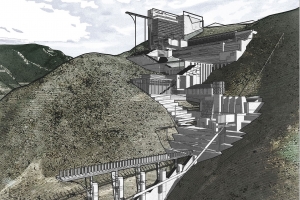
Architecture graduate students Pedro Piñera Rodríguez and Arturo Luján have received an “outstanding proposal” designation in the Third Edition Félix Candela Award competition, an annual international competition presented by the Spanish Institute of Architecture (IESARQ).
Their work will be celebrated in a virtual and in-person festival in Mexico City through December 4 and included in the competition catalogue and a traveling exhibition in Mexico and Spain next year.
The theme of this year’s competition is "Casa Agave," a reflection on the agave plant that appears across Mexico’s landscape and the culture and products that arise from it – most famously, tequila. Mexico produces nearly 100 million gallons of tequila a year, and the industry has taken a toll on the environment. Additionally, the growing interest in alternative sweeteners has led to an increase in agave syrup production, and the plant – nearly 200 species exist – has multiple other uses.
 Piñera and Luján have imagined an elaborate passage and structure that would lead visitors from Guadalajara, Mexico, across the Rio Grande de Santiago, a long river that runs through the heart of agave country, and up into a system of bridges, stairs, terraces, and ramps that lead to facilities high above the riverbank.
Piñera and Luján have imagined an elaborate passage and structure that would lead visitors from Guadalajara, Mexico, across the Rio Grande de Santiago, a long river that runs through the heart of agave country, and up into a system of bridges, stairs, terraces, and ramps that lead to facilities high above the riverbank.
"The agave landscape is suffering serious deterioration,” they write. “The Rio Grande de Santiago, which for millennia has supported the harvest of this native plant, is contaminated and its waters are depleted. Our proposal explores the productive contradictions that could exist between a cultural experience for the appreciation and consumption of agave products, and an intervention at the infrastructure level for the treatment of contaminated river water. The architectural challenge results in a set of volumes and patterns of pedestrian circulation and liquid flows which offer rare confrontations between production and recreation, pollution and consumption.”
Their project is a “speculative geographic fiction,” an architectural design that suggests a story about the interplay of the environment, tourism, and agave cultivation and industry.
“Our intention was that the form, site/context, and representational strategy would suggest the very real tensions that exist in the agave landscape between tourism, agave culture, and pollution and provoke a discussion within the context of the competition and exhibit.”